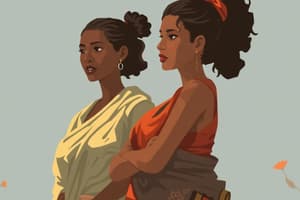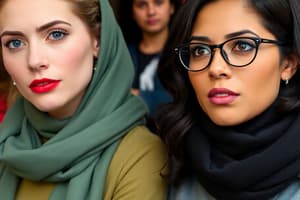Podcast
Questions and Answers
Which of the following best describes the evolution of academic focus from Women's Studies to Gender Studies?
Which of the following best describes the evolution of academic focus from Women's Studies to Gender Studies?
- A reduction in the critique of patriarchal structures, opting instead for a neutral analysis of gender roles.
- A shift towards solely examining LGBT identities, sidelining the study of women's issues.
- A movement away from studying inequality to focusing on biological differences between sexes.
- A broadening of scope to include masculinities, social relations between genders, and diverse gender identities, alongside women's experiences. (correct)
How did second-wave feminist scholarship contribute to the establishment of Women's Studies in US universities?
How did second-wave feminist scholarship contribute to the establishment of Women's Studies in US universities?
- By ignoring the influence of liberation movements and feminist publications.
- By focusing solely on individual psychological differences rather than social structures.
- By critiquing contemporary knowledge as patriarchal and advocating for the academic study of women's marginalization. (correct)
- By reinforcing traditional social analyses and centering male experiences.
How does Kate Millett's 'Sexual Politics' contribute to feminist thought?
How does Kate Millett's 'Sexual Politics' contribute to feminist thought?
- By focusing on economic disparities.
- By ignoring the patriarchal structures.
- By exposing the androcentrism in literature and critiquing patriarchy as a system disadvantaging women. (correct)
- By celebrating the representation of women in the English literary canon.
What is the core argument of West and Zimmerman's 'Doing Gender'?
What is the core argument of West and Zimmerman's 'Doing Gender'?
How has intersectionality enriched the field of Gender Studies?
How has intersectionality enriched the field of Gender Studies?
Why is Christine de Pizan considered a significant figure in the history of feminist thought?
Why is Christine de Pizan considered a significant figure in the history of feminist thought?
What was Mary Wollstonecraft's central argument in 'A Vindication of the Rights of Woman'?
What was Mary Wollstonecraft's central argument in 'A Vindication of the Rights of Woman'?
According to the provided content, what is the significance of Virginia Woolf's 'A Room of One's Own' in the context of feminist history?
According to the provided content, what is the significance of Virginia Woolf's 'A Room of One's Own' in the context of feminist history?
What is the central theme explored in Virginia Woolf's 'Three Guineas'?
What is the central theme explored in Virginia Woolf's 'Three Guineas'?
How does Virginia Woolf's 'Orlando' contribute to discussions about gender and identity?
How does Virginia Woolf's 'Orlando' contribute to discussions about gender and identity?
How did Nancy Chodorow's work contribute to sociological understandings of gender inequality?
How did Nancy Chodorow's work contribute to sociological understandings of gender inequality?
What is the main idea behind structuralist theories of gender as they emerged in the 1970s and 80s?
What is the main idea behind structuralist theories of gender as they emerged in the 1970s and 80s?
How does Rosabeth Kanter's 'Men and Women of the Corporation' (1977) contribute to understanding gender inequality?
How does Rosabeth Kanter's 'Men and Women of the Corporation' (1977) contribute to understanding gender inequality?
What is a common critique of the 'doing gender' approach?
What is a common critique of the 'doing gender' approach?
Which statement best summarizes the relationship between Women’s Studies and feminist values?
Which statement best summarizes the relationship between Women’s Studies and feminist values?
What does Woolf argue is essential for a woman to write fiction in 'A Room of One's Own'?
What does Woolf argue is essential for a woman to write fiction in 'A Room of One's Own'?
In 'Three Guineas', what is Woolf's perspective on gender roles?
In 'Three Guineas', what is Woolf's perspective on gender roles?
What is the main purpose of Woolf's satire of traditional Victorian biographies in 'Orlando'?
What is the main purpose of Woolf's satire of traditional Victorian biographies in 'Orlando'?
According to the provided content, how does Woolf's work relate to ecriture feminine?
According to the provided content, how does Woolf's work relate to ecriture feminine?
According to the information provided, what shared perspectives connected Virginia Woolf and Simone de Beauvoir?
According to the information provided, what shared perspectives connected Virginia Woolf and Simone de Beauvoir?
Flashcards
Gender Studies
Gender Studies
An interdisciplinary field that examines gender inequality, women's experiences, sexuality, masculinity, and the intersection of gender with other inequalities.
Early feminist scholars
Early feminist scholars
Critiqued traditional social analysis for reinforcing gender hierarchies by centering women's experiences.
Kate Millet’s "Sexual Politics"
Kate Millet’s "Sexual Politics"
Exposed the androcentrism in in the English literary canon and critiqued patriarchy as a system disadvantaging women.
"Doing Gender"
"Doing Gender"
Signup and view all the flashcards
Intersectional writing
Intersectional writing
Signup and view all the flashcards
Christine de Pizan
Christine de Pizan
Signup and view all the flashcards
"Vindication of the Rights of Woman"
"Vindication of the Rights of Woman"
Signup and view all the flashcards
Mary Wollstonecraft
Mary Wollstonecraft
Signup and view all the flashcards
Virginia Woolf
Virginia Woolf
Signup and view all the flashcards
"The Story So Far"
"The Story So Far"
Signup and view all the flashcards
"A Room of One’s Own"
"A Room of One’s Own"
Signup and view all the flashcards
Woolf's Argument in "A Room of One's Own"
Woolf's Argument in "A Room of One's Own"
Signup and view all the flashcards
Three Guineas
Three Guineas
Signup and view all the flashcards
Purpose of Three Guineas
Purpose of Three Guineas
Signup and view all the flashcards
Intellectual Footing
Intellectual Footing
Signup and view all the flashcards
Orlando
Orlando
Signup and view all the flashcards
Androgynous Harmony in Orlando
Androgynous Harmony in Orlando
Signup and view all the flashcards
Main points of Three Guineas
Main points of Three Guineas
Signup and view all the flashcards
Purpose of Three Guineas
Purpose of Three Guineas
Signup and view all the flashcards
Feminist History
Feminist History
Signup and view all the flashcards
Study Notes
Precursors to Gender Studies
- The module explores the historical development of Gender Studies, focusing on key figures from the 18th, 19th, and early 20th centuries
- Gender Studies is an interdisciplinary field examining gender inequality, women's experiences, sexuality, masculinity, and the intersection of gender with other inequalities like race and class
- Gender Studies emerged from Women’s Studies during the feminist movement of the 1960s and 70s
- Early feminist scholars critiqued traditional social analysis for reinforcing gender hierarchies by centering women's experiences
- Gender Studies broadened its focus to include masculinity, social relations between genders, and LGBT identities
- Both Women's and Gender Studies recognize that gender inequality significantly shapes individual lives and perspectives
- Feminist scholars methodically established an academic field to address women’s marginalization, influenced by women’s participation in liberation movements and key feminist publications
- Formal Women’s Studies programs began in the late 1960s at US universities
Key Publications and Contributors
- Kate Millet’s "Sexual Politics" (1970) exposed the androcentrism in the English literary canon and critiqued patriarchy as a system disadvantaging women
- Gayle Rubin applied feminist critiques to Freud, Marx, and Levi-Strauss in anthropology, highlighting their neglect of women's lived experiences and the sex-gender system
- Scholarship during the second-wave feminist movement led to the institutionalization of Women’s Studies in US universities
- Women’s Studies critiqued contemporary knowledge as patriarchal, based on privileged male perspectives
- The shift from Women's Studies to Gender Studies reflects a broader inquiry into gender as a system of inequality affecting all individuals
- The growth of masculinities studies examines social expectations around manhood and their role in reproducing power relations
- Nancy Chodorow's work focused on how family structure reproduces gender differences and inequality through early childhood internalization, leading to societal gender inequality. Her "Reproduction of Mothering" was published in 1978
- Sociologists contributed to the conversation by theorizing that gender is a result of social context, not merely internalized personality traits
Structuralist Theories of Gender
- Emerged during the 1970s and 80s, arguing that it is caused by social structures, not psychological differences
- Rosabeth Kanter's structuralist framework, developed in her study of US workplaces, showed how organizational structures disadvantage women. Her work, "Men and Women of the Corporation" (1977), is still relevant
Doing Gender Approach
- Conceptualizes gender as a performance in interpersonal interactions
- West and Zimmerman's "Doing Gender" (1987) argues that individuals "do" gender through daily habits and behaviors, holding each other accountable to cultural standards
- Ethnomethodology studies the socially managed aspects of life that are treated as objective and unchanging
- Critics point out that the "doing gender" approach can interpret behaviors too broadly, without considering if individuals are challenging or undoing gender norms
Modern Gender Studies
- Intersectionality and queer theory have enriched the field by highlighting the interplay of racial and sexual inequalities with gender
- Queer theory is valuable for understanding the fluidity in gender and sexual identities
- Despite global gender inequalities, the social media hashtag #Metoo spread, with women sharing stories of sexual harassment
- Intersectional writing analyzes how gender intersects with other systems of power and oppression
- Feminist works have been central to historical events like women’s suffrage, abolition, and the second-wave feminist movement
- Gender and Women’s Studies have embodied feminist values by interrogating inequality, and perspectives in research
Precursors to Gender Studies
- Early forms of women’s literature critiquing gender inequality can be observed in the 14th and 15th centuries
- Christine de Pizan, an author at the court of King Charles VI of France, was the first female professional writer of the Middle Ages and the first woman of letters in France
- In her 1405 work, "The Book of the City of Ladies," she envisioned a society where women were respected and had equal rights
- Jane Anger's "Her Protection for Women" (1589) provided a feminist critique of men’s treatment of women
- Mary Wollstonecraft's work attacked the authority of Edmund Burke, John Milton, and Jean-Jacques Rousseau, criticizing their views on women
- Her "Vindication of the Rights of Woman" (1792) constructs a model of non-gendered identity to benefit both men and women, foreseeing early 20th-century demands for women’s equality
- Wollstonecraft argued that gender is a social construct and a limitation if it defines personal and social identity
- Other writers influenced by her include Maria Edgeworth, Mary Robinson, Harriet Martineau, Harriet Taylor, J.S. Mill, and George Eliot
- Virginia Woolf is considered a founder of modern feminist literary criticism and her non-fiction writing challenged cultural stereotypes of masculinity and femininity
- Catherine Belsey and Jane Moore's "The Story So Far" (1997) traces the development of feminist thought, highlighting figures like Esther Sowernam, Bathsua Makin, Mary Wollstonecraft, Virginia Woolf, and Simone de Beauvoir
- Her declaration of the "death of the author" brings an alternative collective model of authorship, a questioning of canonicity and a revision of metaphors of gender
- "A Room of One’s Own" (1929) is considered her most significant contribution towards a contemporary understanding of gender
"A Room of One's Own"
- It is based on two lectures on Women and Fiction delivered at Cambridge colleges, lays the foundations for a history of women's literature
- The central idea of the book is freedom, particularly financial freedom, to pursue knowledge and creativity
- The narrator recounts being refused access to a library at Oxbridge due to her gender
- Through the fictionalized character of Mary she argues that literature and history are male constructs that have traditionally marginalized women
- Woolf refutes the assumption that women are inferior writers, instead locating their silence in their material and social circumstances
- She argues that a woman must have money and a room of her own if she is to write fiction
- Her metaphor of the room signifies the declaration of political and cultural space for women
- She explains how women have been barred from attending school and university, excluded by law for inheritance, or expected to marry and spend their time in housekeeping and child rearing
- Woolf imagines the life of Judith Shakespeare, a brilliant, talented, yet imaginary sister of Shakespeare, whom she concludes must have lost her health and sanity
- It anticipates theoretical concerns with the constitution of gender and subjectivity of language by looking at how women’s writings and writings about women are socially perceived
- In the 1920s, masculine values were considered more important than feminine ones.
- Writing about war was considered more important than writing about women's feelings.
Three Guineas
- Three Guineas is a non-fiction book-length essay by Woolf.
- It was initially conceived as a novel-essay to complement A Room of One’s Own.
- The novel part of the initial draft was published as The Years.
- It responds to a letter from a gentleman seeking suggestions on how to stop war.
- Woolf addresses social constrictions on women's participation in social causes
- Woolf addresses managing resources for women's educational institutions.
- Woolf addresses permission for women to enter professions.
- Woolf comments on the patriarchal system and the public world.
- Woolf argues that gender is ambiguous and often fluid, envisaging post-feminist demands.
- Woolf was aware that men and women fit themselves into rigid roles and overlook their personalities.
- In order to grow, there is need to blur what it means to be a real man or a real woman.
- Woolf had lesbian affairs in her life.
- Woolf wrote Orlando, a portrait of her lover Vita Sackville-West.
- Woolf claims it is fatal to be a man or woman pure and simple, one must be woman-manly or man-womanly.
- In Three Guineas, Woolf argued that war can only end by rethinking the habit of pitting sex against sex.
- Woolf believed that claiming superiority and imputing inferiority belong to the private school stage of human existence.
- Woolf wished to raise the status of women in her society.
- The problem was largely down to money, women did not control their own income.
- Women had less intellectual freedom than the sons of Athenian slaves.
- Women have not had a dog’s chance of writing poetry.
- A Room of One’s Own culminated in a specific political demand.
- To stand on the same intellectual footing as men, women need dignity and equal rights to education.
- Women also need an income of 500 pounds a year, and a room of one’s own.
- Traditional literature was severely limited in its ability to represent a person as a whole.
- Binary sex/gender expectations were severely limited in their ability to truly encapsulate an individual’s identity.
Orlando
- Orlando, published in 1928, is a historical pseudo-biography.
- Orlando satirizes more traditional Victorian biographies that emphasized facts and truth.
- Orlando touches on important issues of gender, self-knowledge and truth.
- It describes the adventures of a poet who changes sex and lives for almost four centuries.
- The poet meets the key figures of English literary history.
- The work was inspired by Vita Sackville-West, who was a member of the Bloomsbury Group.
- The separation between sex and gender results in characters embracing an androgynous harmony.
- Characteristics and sexual attractions are individually and internally manifested
- This opposes societal imposition of external expectations determined through biological sexing.
- Orlando also reflects Woolf’s understanding of gender that nudges towards queer theory.
- It contains a much-cited passage on androgyny which has been influential on later deconstructive theories of gender.
- Her narrator declares it is fatal for anyone who writes to think of their sex.
- Woolf touches upon the forced subordinated complicity of women in the construction of the patriarchal subject.
- Laura Doyle insists that Woolf’s interest in the body anticipates feminist investigations of the somatic.
- Woolf’s interest has been understood as materialist, deconstructive and phenomenological.
- The essay’s playful narrative strategies have divided feminist responses, most notably prompting Elaine Showalter’s disapproval.
- Toril Moi’s counter to Showalter’s critique forms the basis of her 1985 work Sexual/Textual Politics.
- Woolf’s textual playfulness anticipates theories of Helene Cixous, Julia Kristeva and Luce Irigaray.
- In between gender identity can be studied through Woolf’s characters like Bernard and Rhoda in The Waves.
- Woolf's characters like Clarissa in Mrs.Dalloway, and Lily in To The Lighthouse also are useful for between gender identity
- In Mrs.Dalloway, Woolf’s subversive use of epiphanic moments portrays female homoeroticism.
- In To The Lighthouse, Lily Briscoe struggles to find a purely feminine form of expression.
- She desires to escape patriarchal ideology and language which accommodates and values only the masculine identity.
- In The Waves, the desire of returning to the maternal space creates a specific language for characters.
- This language may be considered as an example of ecriture feminine.
Feminism
- In feminist history, A Room of One’s Own became a beacon for female independence and feminist standpoint.
- Simone de Beauvoir also influenced the future of gender studies.
- Woolf and Beauvoir had a strong sense of personality while rebelling against patriarchal society.
- They also had shared opinions on marriage, reproduction and homosexuality.
Studying That Suits You
Use AI to generate personalized quizzes and flashcards to suit your learning preferences.




